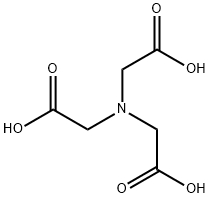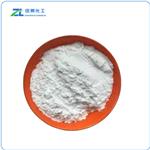Chemical Properties
Nitrilotriacetic acid, also known as NTA, is a white crystalline powder. It can dissolve in ammonia and alkali solutions while being slightly soluble in hot water. However, it is insoluble in water and most organic solvents. NTA can form mono-, di-, and tribasic salts, all of which are soluble in water. Combustible. 70% biodegradable.
Uses
Used in sequestration of metals; chelometric analysis.
Uses
Nitrilotriacetic acid is a chelating agent which forms coordination compounds with metal ions. Nitrilotriacetic acid is used in complexometric titrations and as well as for protein isolation and purification in the His-tag method. This compound is a contaminant of emerging concern (CECs).
Definition
ChEBI: Nitrilotriacetic acid is a tricarboxylic acid and a NTA. It has a role as a nephrotoxic agent and a carcinogenic agent. It is a conjugate acid of a nitrilotriacetate(1-).
Preparation
The synthesis of nitrilotriacetic acid involves the following steps:
Chloroacetic acid is reacted with sodium hydroxide to produce sodium chloroacetate.
Sodium chloroacetate then reacts with ammonium chloride to form sodium aminotriacetate.
The resulting sodium aminotriacetate is acidified to obtain nitrilotriacetic acid.
Synthesis Reference(s)
The Journal of Organic Chemistry, 15, p. 46, 1950
DOI: 10.1021/jo01147a008
Air & Water Reactions
Water Insoluble.
Reactivity Profile
Nitrilotriacetic acid is incompatible with strong oxidizers, aluminum, copper, copper alloy and nickel. Nitrilotriacetic acid is also incompatible with strong bases.
Hazard
Possible carcinogen.
Health Hazard
Toxicity and health hazard of Nitrilotriacetic acid is low. Contact with eyes causes irritation.
Fire Hazard
Flash point data for Nitrilotriacetic acid are not available; however, Nitrilotriacetic acid is probably combustible.
Flammability and Explosibility
Non flammable
reaction suitability
reagent type: reductant
Biological Activity
Nitrilotriacetic (NTA) has the ability to link with histidine side chain of proteins. It can be used in fluorescent labelling, hexahistidine (His6)-tagged proteins for purification and surface immobilization.
Safety Profile
Confirmed carcinogen with experimental carcinogenic and neoplastigenic data. Poison by intraperitoneal route. Moderately toxic by ingestion. When heated to decomposition it emits toxic fumes of NOx,.
Potential Exposure
Nitrilotriacetic acid (NTA) was used
as a phosphate replacement in laundry detergents in the late
1960s. In 1971, the use of NTA was discontinued. The possibility
of resumed use arose in 1980. NTA is now used in
laundry detergents in states where phosphates are banned.
NTA is also used as a boiler feed-water additive at a maximum
use level of 5 ppm of trisodium salt. Currently, the
remaining nondetergent uses of NTA are for water treatment,
textile treatment; metal plating and cleaning; and
pulp and paper processing.
Carcinogenicity
Nitrilotriacetic acid is reasonably anticipated to be a human carcinogen based on sufficient evidence of carcinogenicity from studies in experimental animals.
Shipping
UN2811 Toxic solids, organic, n.o.s., Hazard
Class: 6.1; Labels: 6.1-Poisonous materials, Technical
Name Required.
Waste Disposal
Dissolve or mix the material
with a combustible solvent and burn in a chemical
incinerator equipped with an afterburner and scrubber.
All federal, state, and local environmental regulations must
be observed.







